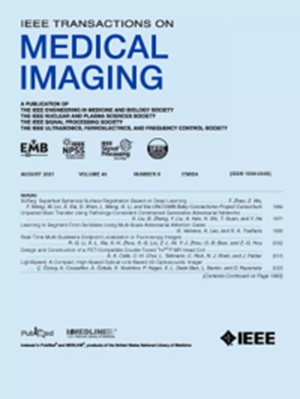Automatic Choroid Segmentation and Thickness Measurement Based on Mixed Attention-guided Multiscale Feature Fusion Network.
IF 9.8
1区 医学
Q1 COMPUTER SCIENCE, INTERDISCIPLINARY APPLICATIONS
引用次数: 0
Abstract
Choroidal thickness variations serve as critical biomarkers for numerous ophthalmic diseases. Accurate segmentation and quantification of the choroid in optical coherence tomography (OCT) images is essential for clinical diagnosis and disease progression monitoring. Due to the small number of disease types in the public OCT dataset involving changes in choroidal thickness and the lack of a publicly available labeled dataset, we constructed the Xuzhou Municipal Hospital (XZMH)-Choroid dataset. This dataset contains annotated OCT images of normal and eight choroid-related diseases. However, segmentation of the choroid in OCT images remains a formidable challenge due to the confounding factors of blurred boundaries, non-uniform texture, and lesions. To overcome these challenges, we proposed a mixed attention-guided multiscale feature fusion network (MAMFF-Net). This network integrates a Mixed Attention Encoder (MAE) for enhanced fine-grained feature extraction, a deformable multiscale feature fusion path (DMFFP) for adaptive feature integration across lesion deformations, and a multiscale pyramid layer aggregation (MPLA) module for improved contextual representation learning. Through comparative experiments with other deep learning methods, we found that the MAMFF-Net model has better segmentation performance than other deep learning methods (mDice: 97.44, mIoU: 95.11, mAcc: 97.71). Based on the choroidal segmentation implemented in MAMFF-Net, an algorithm for automated choroidal thickness measurement was developed, and the automated measurement results approached the level of senior specialists.基于混合注意引导的多尺度特征融合网络的脉络自动分割与厚度测量。
脉络膜厚度变化是许多眼科疾病的重要生物标志物。光学相干断层扫描(OCT)图像中脉络膜的准确分割和定量对临床诊断和疾病进展监测至关重要。由于公共OCT数据集中涉及脉络膜厚度变化的疾病类型较少,并且缺乏公开可用的标记数据集,我们构建了徐州市医院(XZMH)-脉络膜数据集。该数据集包含正常和八种脉络膜相关疾病的注释OCT图像。然而,由于边界模糊、纹理不均匀和病变等混杂因素,OCT图像中脉络膜的分割仍然是一个巨大的挑战。为了克服这些挑战,我们提出了一种混合注意力引导的多尺度特征融合网络(MAMFF-Net)。该网络集成了用于增强细粒度特征提取的混合注意编码器(MAE),用于跨病变变形进行自适应特征集成的可变形多尺度特征融合路径(DMFFP),以及用于改进上下文表示学习的多尺度金字塔层聚合(MPLA)模块。通过与其他深度学习方法的对比实验,我们发现MAMFF-Net模型比其他深度学习方法具有更好的分割性能(mdevice: 97.44, mIoU: 95.11, mAcc: 97.71)。在MAMFF-Net实现脉络膜分割的基础上,开发了脉络膜厚度自动测量算法,自动测量结果接近高级专家水平。
本文章由计算机程序翻译,如有差异,请以英文原文为准。
求助全文
约1分钟内获得全文
求助全文
来源期刊

IEEE Transactions on Medical Imaging
医学-成像科学与照相技术
CiteScore
21.80
自引率
5.70%
发文量
637
审稿时长
5.6 months
期刊介绍:
The IEEE Transactions on Medical Imaging (T-MI) is a journal that welcomes the submission of manuscripts focusing on various aspects of medical imaging. The journal encourages the exploration of body structure, morphology, and function through different imaging techniques, including ultrasound, X-rays, magnetic resonance, radionuclides, microwaves, and optical methods. It also promotes contributions related to cell and molecular imaging, as well as all forms of microscopy.
T-MI publishes original research papers that cover a wide range of topics, including but not limited to novel acquisition techniques, medical image processing and analysis, visualization and performance, pattern recognition, machine learning, and other related methods. The journal particularly encourages highly technical studies that offer new perspectives. By emphasizing the unification of medicine, biology, and imaging, T-MI seeks to bridge the gap between instrumentation, hardware, software, mathematics, physics, biology, and medicine by introducing new analysis methods.
While the journal welcomes strong application papers that describe novel methods, it directs papers that focus solely on important applications using medically adopted or well-established methods without significant innovation in methodology to other journals. T-MI is indexed in Pubmed® and Medline®, which are products of the United States National Library of Medicine.
 求助内容:
求助内容: 应助结果提醒方式:
应助结果提醒方式:


